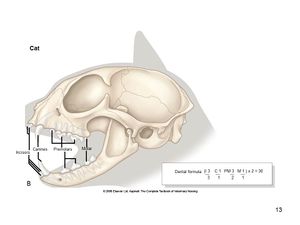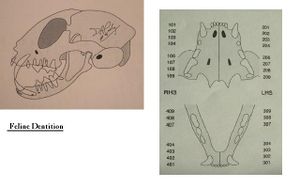Difference between revisions of "Dental Formula - Cat"
Jump to navigation
Jump to search
LisaMilella (talk | contribs) (→Molars) |
|||
| Line 22: | Line 22: | ||
Image:Feline Dentition.jpg|Feline Dentition - Copyright Nottingham 2008 | Image:Feline Dentition.jpg|Feline Dentition - Copyright Nottingham 2008 | ||
</gallery></center> | </gallery></center> | ||
| + | {{Lisa Milella reviewed | ||
| + | |date = July 28, 2013}} | ||
{{OpenPages}} | {{OpenPages}} | ||
[[Category:Teeth - Anatomy & Physiology]] | [[Category:Teeth - Anatomy & Physiology]] | ||
Revision as of 13:17, 13 August 2013
Introduction
Cats are toothless at birth. Deciduous teeth are complete and functional within 2 months of birth. Permanent teeth are complete and functional by the end of the 6th month.
The formula for deciduous teeth: 2 (i3/3 c1/1 p3/2)
The formula for permanent teeth: 2 (I3/3 C1/1 P3/2 M1/1)
Premolars
Cats are normally missing the maxillary 1st premolar and the mandibular 1st and 2nd premolars
Molars
A decrease in the number of molars leaves the cat with a shearing bite, rather than wider cusps for grinding.
Image from Aspinall, The Complete Textbook of Veterinary Nursing, Elsevier Health Sciences, All rights reserved
| This article was expert reviewed by Lisa Milella BVSc DipEVDC MRCVS. Date reviewed: July 28, 2013 |
Error in widget FBRecommend: unable to write file /var/www/wikivet.net/extensions/Widgets/compiled_templates/wrt693abfd38b97a0_71227405 Error in widget google+: unable to write file /var/www/wikivet.net/extensions/Widgets/compiled_templates/wrt693abfd390cb79_63942453 Error in widget TwitterTweet: unable to write file /var/www/wikivet.net/extensions/Widgets/compiled_templates/wrt693abfd3957f34_56889482
|
| WikiVet® Introduction - Help WikiVet - Report a Problem |

